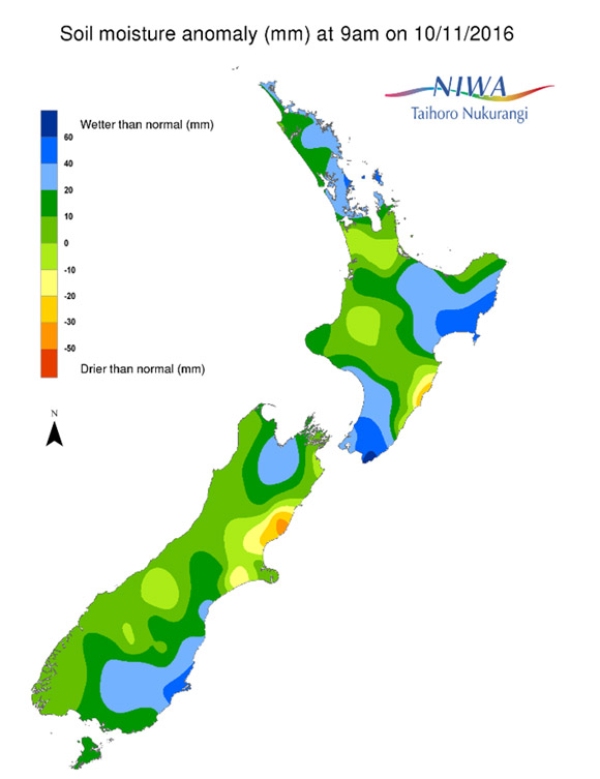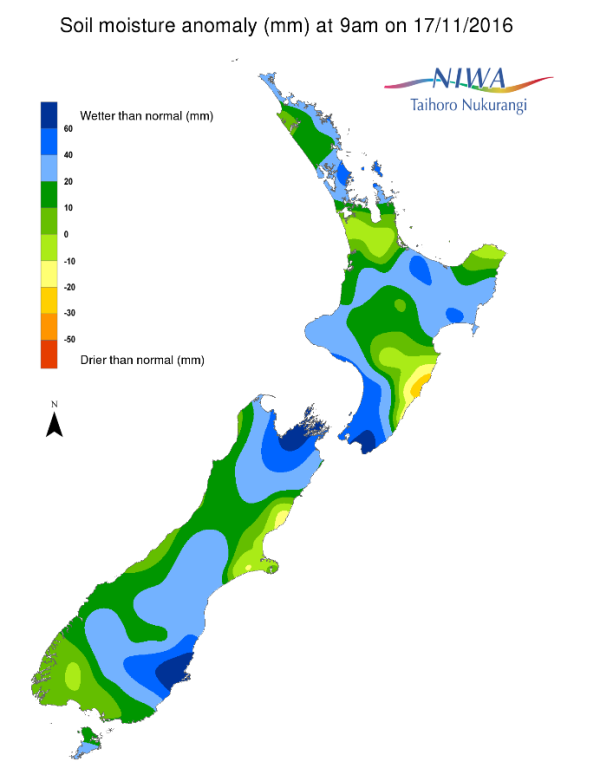For 17 November 2016
A weekly update describing soil moisture across the country to help assess whether severely to extremely dry conditions are occurring or imminent. Regions experiencing these soil moisture deficits are deemed “hotspots”. Persistent hotspot regions have the potential to develop into drought.
Facts: soil moisture
Across the North Island, soil moisture levels have generally increased in southern areas since this time last week. Substantial increases were observed in much of Wellington, Wairarapa, coastal Manawatu-Wanganui, and Taranaki. Smaller increases also occurred in northern Manawatu-Wanganui, southern Waikato, and central Bay of Plenty. Meanwhile, small decreases in soil moisture levels were observed in Gisborne and Hawke’s Bay. The driest soils across the North Island compared to normal for this time of the year are found along the southern coast of Hawke’s Bay, while the wettest soils for this time of the year are found in southern Wairarapa.
Across the South Island, soil moisture levels have generally increased since this time last week. Substantial increases were observed throughout Nelson, Tasman, and Marlborough, interior Canterbury, and coastal Otago. Significant increases also occurred in northern Canterbury, which caused a hotspot in coastal Hurunui district to dissipate. Meanwhile, small decreases in soil moisture levels were observed in western Southland. The driest soils in the South Island compared to normal for this time of the year are still found in northern Canterbury (despite significant improvement), while the wettest soils for this time of year are found in coastal Otago, Nelson, and western Marlborough.
Outlook and soil moisture
For the North Island, waves of heavy showers will move through this afternoon and early evening, producing pockets of 10-20 mm rainfall in western and central areas. However, much of the rest of the North Island will receive less than 10 mm. Scattered light showers will occur on Friday (18th November), but any rainfall will be less than 5 mm. Western and central areas will again see showers on Saturday, with up to 10 mm in spots. However, any rainfall in the rest of the North Island will be minimal. Beginning on Sunday, high pressure will bring dry weather through to Wednesday (23rd November).
With low rainfall expected, there is a chance for a hotspot to develop along the southern coast of Hawke’s Bay in the next week. While little change in soil moisture levels is expected in western and central areas, the rest of the North Island will likely see soil moisture levels decrease in the next week.
For the South Island, significant rainfall has moved across Canterbury today, producing widespread rainfall of 15-25 mm. Lower amounts of 5-15 mm are expected in Otago and Southland. After dry weather on Friday (18th November), showers on Saturday will produce 5-15 mm on the West Coast. Additional showers will continue on the West Coast on Sunday, Monday, and Tuesday, with generally light amounts each day. Heavier rain may come to Southland and Fiordland on Wednesday, with 10-20 mm possible (isolated 50 mm in Fiordland).
No official hotspots are expected to develop in the South Island in the next week. However, soils will likely become drier in interior Otago as well as in the northern South Island.


